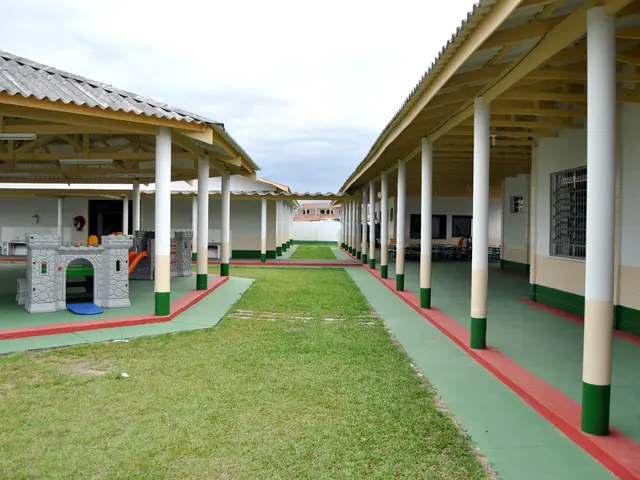Investigating the Relationship Between Technological Advancements and Workplace Security Practices
Today's digital tools are shaking up the way we stay safe at work. From AI-powered risk detection to real-time sensors, progress is happening at a breakneck pace. But are these advancements actually solving the right problems or merely adding new ones?
Let's dive into the complex intersection of technology and workplace safety and see where it leads us.
The Digital Shield: Smart Sensors and AI Alerts
Modern digital tools are helping reduce safety risks even before they materialize. Wearable devices monitor posture, stress, and movement in real-time, while smart sensors keep tabs on factory floor air quality and temperature changes.
Recent research by ScienceDirect demonstrates that cheap sensors can monitor air quality in factories, feeding data to IoT systems for meaningful insights. This technology is vital for improving safety and efficiency in industrial environments.
These alerts help prevent fatigue, chemical exposure, and sudden equipment failure, offering swift emergency response when conditions deteriorate. They also generate valuable data to inform workplace design and hazard planning, benefiting both workers and management.
However, the constant tracking raises inevitable privacy and transparency questions. Workers deserve to know how their data is used and protected daily. Safety technology should strike an equilibrium between risk prevention and respect for personal boundaries.
What happens when sensors malfunction unexpectedly?
Sensor malfunctions can provide a false sense of security, exposing workers to overlooked hazards. Emergency protocols should outline responses to sensor failures using manual checks and human judgment. Backup systems and traditional tools are indispensable during digital monitoring's lapses.
Automation: A Mixed Blessing for Dangerous Tasks
Automation reduces human exposure to hazardous and physically demanding tasks. For instance, robots can safely handle toxic chemicals and stabilize unsteady environments.
A 2025 study, published on ResearchGate, highlights robots' transformative role in hazardous waste cleanup and disaster response. These intelligent machines make use of AI and sensors to carry out dangerous tasks with accuracy. Utilizing robots in these roles lowers injury rates, expedites recovery, and boosts overall efficiency.
That said, automation may weaken critical hands-on experience among workers. Human oversight is crucial to prevent serious malfunctions or oversights and to respond swiftly when an automated tool fails.
Workers should receive training in both digital controls and manual fallback procedures. Additionally, the continued use of harmful materials in otherwise automated settings necessitates their replacement.
What ethical concerns arise from robotic deployment?
A lack of accountability in robotic deployment leads to confusion when failures occur. To ensure safety, autonomous decisions need transparency, traceability, and scrutiny after incidents. Robust oversight is essential to guarantee that human operators retain responsibility for outcomes that directly impact workers' well-being.
Rethinking Yesterday's Materials in Today's Technological Landscape
Despite the advancement of digital safety systems, various harmful materials remain in use. Although smart monitors can detect airborne toxins, they don't replace the sources. Many factories still contain aging insulation and materials like asbestos and silica that continue to pose threats.
Legal action against manufacturers of hazardous chemicals or materials like AFFF firefighting foam highlights the stain left behind by outdated substances. The AFFF foam lawsuit raises concerns about manufacturers' knowledge of the dangers but their failure to inform or replace the materials.
In essence, the modern tech ecosystem must assess and replace legacy materials upon which it is built. Workplace innovation can't rely solely on detection and monitoring; true safety demands the identification and removal of hazards.
Can 3D printing replace hazardous components?
3D printing allows safe, custom parts that substitute high-risk materials used in outdated systems. By utilizing 3D printing solutions, facilities can design alternatives that perform better while reducing exposure to toxic chemicals and dust. This move lowers long-term liability and improves equipment safety and sustainability.
AI and the Ethics of Safety Decision Making
AI-driven systems help identify risks much faster than traditional methods can, but over-reliance on them can remove essential human judgment and interpretation. This can lead to inaccurate safety alerts, particularly when data quality and algorithm bias are issues.
The oversight of AI predictions and decisions remains essential to catch anything it may have missed. Ethical design should ensue that workers understand how AI makes its decisions and provide transparent communication to build trust.
What happens if AI safety systems use outdated information?
AI requires diverse and up-to-date data inputs to interpret workplace safety needs effectively. Contextual training must reflect human behavior, environmental changes, and non-standard scenarios across industries. Regular retraining with updated incident reports helps AI systems stay current with new workplace risks.
Educating the Workforce for a Safer Digital Tomorrow
Advanced safety tools are valuable only when workers know how to utilize them. Training should encompass digital platforms, wearable devices, and data dashboards. Clarity in instructions empowers employees to respond quickly and effectively to alerts. Continuous learning must be offered to accommodate system updates and evolution.
The American Machinist stresses that continuous learning is crucial in manufacturing as technology swiftly changes job skill requirements. Without ongoing training, workers risk falling behind technologically, hindering their career progression.
Workers with strong digital literacy are better prepared to identify potential issues. Safety cultures flourish when communication is open and constructive feedback is encouraged.
Employees must feel confident in offering improvements to existing technologies and routines. Employers should merge digital training with on-the-ground safety procedures and drills. A strong safety culture relies on education, access, and shared responsibility.
What skills help bridge the gap between tech and manual safety?
The combination of digital skills with traditional hazard awareness equips workers to interpret digital alerts during real-world emergencies. Successfully employing technology in workplace safety necessitates a holistic approach, aiming past hazard detection to the active prevention of threats before they occur.
AI and sensors offer potent tools for risk reduction, but require strong data accuracy and privacy protections. Human oversight is crucial to catch what technology may miss. A modern tech ecosystem needs to carefully reassess the legacy materials it operates upon. Removing hazards, not just observing them through a digital lens, serves as the foundation for sustainable, comprehensive safety reform.
- The integration of AI and smart sensors in the workplace is transforming the way we approach safety, offering real-time monitoring of posture, stress, air quality, and temperature changes.
- A study on ResearchGate shows that robots, with their AI and sensor capabilities, can significantly improve safety and efficiency in disaster response and hazardous waste cleanup.
- However, relying too heavily on automation may lead to a lack of hands-on experience among workers, emphasizing the need for human oversight to prevent serious malfunctions or oversights.
- Workers deserve transparency and understanding of how their data is used in these digital safety tools, ensuring respect for personal boundaries.
- The modern tech landscape must reassess and replace legacy materials that remain hazardous, as seen with the AFFF foam lawsuit, to ensure true safety in the workplace.
- The use of 3D printing in safety systems can lead to the creation of custom parts that substitute high-risk materials, improving equipment safety, sustainability, and reducing exposure to toxic chemicals and dust.
- AI-driven safety systems require diverse, up-to-date data inputs to interpret workplace safety needs accurately, and regular retraining to stay current with new workplace risks.
- For a safer digital future, continuous education and learning is essential for workers, empowering them to utilize digital safety tools effectively, identify potential issues, and contribute to a safety culture that relies on shared responsibility.







